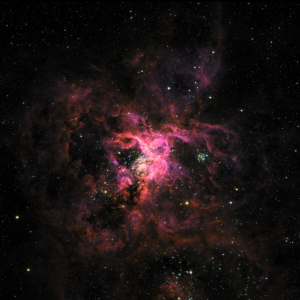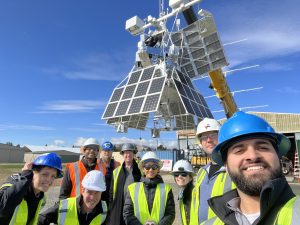Earlier this year, astronomers successfully launched a balloon-borne telescope that captured extraordinary images of the Universe on its first flight above the Earth’s atmosphere. The Super Pressure Balloon-Borne Imaging Telescope (SuperBIT) was flown to the edge of space by a helium-filled NASA scientific balloon the size of a football stadium, where it also helped researchers investigate the mystery of dark matter.

A false-colour image of the “Tarantula Nebula” taken in visible and ultraviolet light by the SuperBIT telescope shortly after launch. Credit: SuperBIT.
Among the first images taken on this flight, SuperBIT captured the “Tarantula Nebula” — a bright cluster of gas and dust in a galaxy neighbourhood near our Milky Way — and the collision between the two galaxies, NGC 4038 and NGC 4039, known as “the Antennae.”
SuperBIT is a collaboration between Durham University, the University of Toronto, Princeton University, NASA, and the Canadian Space Agency. It launched from Wānaka, New Zealand earlier this year, following a two-year delay due to the COVID pandemic. SuperBIT circumnavigated the southern hemisphere several times — imaging the sky all night, then using solar panels to recharge its batteries during the day.
SuperBIT flies at an altitude of 40km, above 99.5 per cent of the Earth’s atmosphere. It takes high-resolution images like those from the Hubble Space Telescope, but with a much wider field of view.
The science goal for this first flight was to measure the properties of dark matter, a heavy but invisible type of material. Dark matter is all around us but poorly understood. SuperBIT aims to test whether dark matter particles can bounce off each other, by mapping the dark matter around clusters of galaxies that are colliding with neighbouring galaxy clusters.
Various theories about dark matter suggest that, during a collision, some dark matter might either slow down, spread out, or get chipped off. The researchers say that if they can map dark matter leaving the collision, they could finally start to learn what it is made of.
“A dedicated team of students developing one of the world’s great telescopes – it’s inspiring,” says Barth Netterfield, a Professor at the David A. Dunlap Department of Astronomy and Astrophysics and Department of Physics at the University of Toronto, and an Associate at the Dunlap Institute for Astronomy and Astrophysics. “And now, after a decade of tremendous effort, we are getting these exquisite images with a wide range of science goals, which will help us to better understand the Universe.”
Funding for the SuperBIT mission has been provided by NASA, the Canadian Space Agency, the Royal Society, and the Dunlap Institute for Astronomy and Astrophysics.
The documentary was filmed and directed by Jonathan Qu and Kevin Li.

